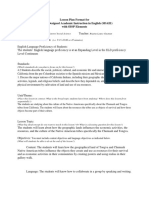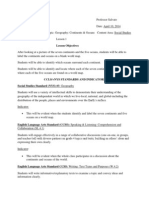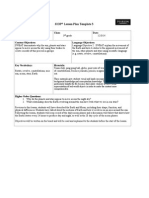Lessonplan 1
Lessonplan 1
Uploaded by
api-240859589Copyright:
Available Formats
Lessonplan 1
Lessonplan 1
Uploaded by
api-240859589Original Title
Copyright
Available Formats
Share this document
Did you find this document useful?
Is this content inappropriate?
Copyright:
Available Formats
Lessonplan 1
Lessonplan 1
Uploaded by
api-240859589Copyright:
Available Formats
Essential Questions
Standards of Learning (be sure to Social Studies 2.5The student will develop map skills by a) locating the equator, the seven continents, and the five oceans on maps include integrated and globes; standards here too)
Math 2.16 The student will identify, describe, compare, and contrast plane and solid geometric figures (circle/sphere, square/cube, and rectangle/rectangular prism). English 2.2 The student will expand understanding and use of word meanings. a) Increase listening and speaking vocabularies. c) Clarify and explain words and ideas orally. e) Use vocabulary from other content areas.
How is our planets geography represented? Why are maps and globes important in our lives? What are some major features on a map/globe of planet Earth? Where are the seven continents, the five oceans, and the equator located on maps and globes? People, Places, and Environments
Objectives
Materials
Procedures (introduction, instructional strategies, summary/close)
Students will be able to demonstrate their understanding that a map is flat and a globe is three dimensional - Students will be able to identify the plane or solid geometric figure of a map (square or rectangle) and a globe (sphere) - Students will be able to describe why maps and globes are important in our livesthey help us understand the settings against which different cultures thrive, historical events happened, and current events happen today. - Students will be able to distinguish between an ocean and a continent on a map. - The students will need about 20 paper maps (about half square shaped and half rectangle shaped) and eight globes. The students will need an exit ticket to demonstrate their current understanding. - The teacher will need the book Maps and Globes by Jack Knowlton and Harriet Barton. The teacher will also need large labels that say Square, Rectangle, and Sphere Introduction (5 minutes): 1) The teacher will put five maps and two globes on each of the four groups tables. She will explain that the students should group these representations of the geography of our planet into categories. The teacher will let the students work in groups to choose their own categories. Instructional strategies (30 minutes): 1) As the students work to group their objects, the teacher will rotate between the groups and ask each group for their reasoning. She will prompt them to categorize their objects so that the square maps are in one category, rectangular maps are in another, and the spherical globes are in the third category. 2) After students have made their groups, the teacher will ask questions to see if students know the words map, globe, rectangle, square, or sphere. As necessary, the teacher will elaborate on or introduce these terms. The teacher will draw connections to the idea that ways to represent our planet come in different
Formative Assessment Differentiation
forms. 3) The teacher will then transition from this activity to a read-aloud by asking the students to come quickly and quietly to the carpet. The teacher will tell the students that they are going to learn more about maps and globes and will begin reading Maps and Globes by Jack Knowlton and Harriet Barton. As the teacher reads, she will prompt the students to discuss why our representations of the planet have changed over time. The teacher will also prompt students to discuss the difference between a map and a globe, prompting them to use new vocabulary. As the students look at some of the maps in the book, the teacher will prompt them to point out what part of the map is ocean and what part is a continent, a large body of land. Toward the end of the book, the teacher will ask for examples of why maps and globes of the world are important and useful in our lives. Summary (5 minutes) 1) The teacher will end the book and ask the students if they have any questions. She will then preview that during the next days lesson the class will learn more about their classmates, maps and globes, and the worlds oceans and continents. 2) The students will complete an exit ticket. If the students do not know the answer to the last question (where their family or ancestors lived before moving to Virginia), the teacher will ask the students to find out from their parents as homework. - The students will complete a written exit ticket to assess their knowledge of the objectives. Students who are English learners or are at a low reading level will have the exit ticket read to them. The exit ticket will provide the options for students to write or draw. During the introduction, students who are struggling with sorting the objects will have additional scaffolding from the teacher. During the readaloud students who have trouble seeing or hearing will sit closer to the teacher. As an extension for students who easily sort the objects, the teacher will prompt them to think about why we often represent the world in these two different ways. The teacher will also prompt those students to think about how it would look if we represented our geography as a cube or triangle. Of Gardners multiple intelligences, this lesson will especially help learners that are strong in the following intelligences: visual-spatial (sorting the shapes), bodily-kinesthetic (the physical nature of the sorting), interpersonal (working in groups and class discussion), linguistic (class read-aloud and discussion), and logical-mathematical (sorting the shapes)
You might also like
- A Study On The Impact of Mandatory ROTCDocument23 pagesA Study On The Impact of Mandatory ROTClorina lingcodo87% (38)
- BOOK Novice To Expert 6 Steps To Learn Anything, Increase Your Knowledge, and Master New Skills-SJ Scott PDFDocument114 pagesBOOK Novice To Expert 6 Steps To Learn Anything, Increase Your Knowledge, and Master New Skills-SJ Scott PDFhappygirlhot100% (2)
- Concept Attainment LessonDocument5 pagesConcept Attainment LessonMariah McKinnon100% (4)
- Analyze Learners: "Basic World Geography" 2 Grade Geography Lesson Length: 180 Minutes, or Three Class PeriodsDocument4 pagesAnalyze Learners: "Basic World Geography" 2 Grade Geography Lesson Length: 180 Minutes, or Three Class Periodsapi-337364062No ratings yet
- Where We Are in Place in Time 1 17 13Document4 pagesWhere We Are in Place in Time 1 17 13api-147600993No ratings yet
- Earths Interior Lesson PlanDocument4 pagesEarths Interior Lesson Planapi-26453381875% (4)
- 10 Geography Lesson Plans for KS1 - Volume 1: Our School and the Local Area & An Island HomeFrom Everand10 Geography Lesson Plans for KS1 - Volume 1: Our School and the Local Area & An Island HomeNo ratings yet
- LP 5Document3 pagesLP 5api-240859589No ratings yet
- LP 2Document3 pagesLP 2api-240859589No ratings yet
- Lesson Foundations: Middle Childhood Education Lesson Plan Template v. 2Document19 pagesLesson Foundations: Middle Childhood Education Lesson Plan Template v. 2api-340860586No ratings yet
- Map Skills Lesson Plan 1Document7 pagesMap Skills Lesson Plan 1api-240434269100% (1)
- Layers of The Earth Lesson PlanDocument3 pagesLayers of The Earth Lesson Planapi-240608311No ratings yet
- Unit 2 Lesson 3Document3 pagesUnit 2 Lesson 3api-240273723No ratings yet
- LP 4Document3 pagesLP 4api-240859589No ratings yet
- Geography Lesson PlanDocument4 pagesGeography Lesson Planapi-204977805100% (3)
- Sose Unit CompleteDocument18 pagesSose Unit Completeapi-263184946No ratings yet
- Map Skills Lesson Plan 2Document7 pagesMap Skills Lesson Plan 2api-240434269No ratings yet
- EDRD 6150 Lesson Plan Form 3Document3 pagesEDRD 6150 Lesson Plan Form 3Tiandra CantyNo ratings yet
- LP 3Document3 pagesLP 3api-240859589No ratings yet
- Map Skills Lesson Plan 3Document4 pagesMap Skills Lesson Plan 3api-240434269No ratings yet
- Lesson Plan 3Document3 pagesLesson Plan 3api-267997493No ratings yet
- Lesson Plan 1Document7 pagesLesson Plan 1api-241193898No ratings yet
- CWSLesson PlanDocument3 pagesCWSLesson PlandcbarrowNo ratings yet
- Pba Lesson 4Document3 pagesPba Lesson 4api-302824532No ratings yet
- Triangles Lesson PlanDocument5 pagesTriangles Lesson PlanalyssamanningNo ratings yet
- Unit 2 Lesson 4Document3 pagesUnit 2 Lesson 4api-240273723No ratings yet
- Creation of The Earth-Lesson Plan 1Document6 pagesCreation of The Earth-Lesson Plan 1hannahtubbs001No ratings yet
- Social Stud WeebDocument2 pagesSocial Stud Weebapi-240110497No ratings yet
- EDU 325 - Group Lesson PlanDocument8 pagesEDU 325 - Group Lesson Plandrd92No ratings yet
- Unit 2 Lesson 2Document4 pagesUnit 2 Lesson 2api-240273723No ratings yet
- Mallarie Lesson Plan 2Document4 pagesMallarie Lesson Plan 2api-241274409No ratings yet
- SeasonsDocument4 pagesSeasonsapi-248425823No ratings yet
- Ss Unit-Lesson Plan 4Document4 pagesSs Unit-Lesson Plan 4api-241269773No ratings yet
- Unit Plan Lesson Plan-DanaDocument5 pagesUnit Plan Lesson Plan-Danaapi-270055102No ratings yet
- Astronomy Unit PlanDocument17 pagesAstronomy Unit PlanMariah McKinnonNo ratings yet
- Correctedlp2 TwestDocument19 pagesCorrectedlp2 Twestapi-340860586No ratings yet
- Lesson 2Document4 pagesLesson 2api-297076449No ratings yet
- Lesson Plan 3Document3 pagesLesson Plan 3api-261801340No ratings yet
- Grade: 4th NCSS Standard:: People, Places, and EnvironmentsDocument5 pagesGrade: 4th NCSS Standard:: People, Places, and EnvironmentsMatthew BrownNo ratings yet
- Unit 2 Lesson 5Document3 pagesUnit 2 Lesson 5api-240273723No ratings yet
- Ss Unit-Lesson Plan 1Document3 pagesSs Unit-Lesson Plan 1api-241269773No ratings yet
- Map Skills Lesson Plan 5Document6 pagesMap Skills Lesson Plan 5api-240434269No ratings yet
- Grade 6 Global Issues UnitDocument29 pagesGrade 6 Global Issues UnitgpereyraNo ratings yet
- Murdock Butler Mini-Lesson PlansDocument3 pagesMurdock Butler Mini-Lesson Plansapi-329772021No ratings yet
- Edu 512-Concept Attainment Lesson Plan Form 18 2Document11 pagesEdu 512-Concept Attainment Lesson Plan Form 18 2api-446896078No ratings yet
- Curriculum Map 1Document5 pagesCurriculum Map 1api-290161221No ratings yet
- Edu 155 History Lesso Plan Regina LopezgDocument5 pagesEdu 155 History Lesso Plan Regina Lopezgapi-405041071No ratings yet
- Maps Lesson PlanDocument8 pagesMaps Lesson Planapi-364942122100% (2)
- Earth History Timeline Student Information Sheet: Unit 3 - 1Document16 pagesEarth History Timeline Student Information Sheet: Unit 3 - 1mesaprietaNo ratings yet
- 504 Geography World Lesson 1Document5 pages504 Geography World Lesson 1api-252899604No ratings yet
- Solar System Lesson PlanDocument5 pagesSolar System Lesson PlanKayla RhodesNo ratings yet
- Science Lesson For ElDocument3 pagesScience Lesson For Elapi-279742832No ratings yet
- Final Integrated UnitDocument20 pagesFinal Integrated Unitapi-387295976No ratings yet
- EDRD 6150 Lesson Plan Form2Document3 pagesEDRD 6150 Lesson Plan Form2Tiandra CantyNo ratings yet
- Social Studies Lesson PlanDocument5 pagesSocial Studies Lesson Planapi-316263044No ratings yet
- Egp 335 Day 1Document6 pagesEgp 335 Day 1api-301880625No ratings yet
- Lesson Plan 2Document6 pagesLesson Plan 2api-299952808No ratings yet
- Lesson Plan For Ss Anne of Green GablesDocument5 pagesLesson Plan For Ss Anne of Green Gablesapi-311313472No ratings yet
- Unit Plan P I II Final Draft 2 Our VersionDocument19 pagesUnit Plan P I II Final Draft 2 Our Versionapi-248716727No ratings yet
- I. Standards: (ALCOS) Social Studies (2004) Grade 2: Maps and Globes1Document2 pagesI. Standards: (ALCOS) Social Studies (2004) Grade 2: Maps and Globes1api-219775786No ratings yet
- Ss Unit - Lesson Plan 3Document4 pagesSs Unit - Lesson Plan 3api-241269773No ratings yet
- Science Lesson PlanDocument6 pagesScience Lesson Planapi-280508393No ratings yet
- Naskah Soal Uts Kelas 7 Bahasa InggrisDocument4 pagesNaskah Soal Uts Kelas 7 Bahasa InggrisToto T. PrihantoNo ratings yet
- Action Plan For The Construction of The Lavatory and Improvement of The Comfort RoomDocument6 pagesAction Plan For The Construction of The Lavatory and Improvement of The Comfort RoomMay-ann Ramos Galliguez ValdezNo ratings yet
- Letter of Recommendation-Celeste TafeDocument1 pageLetter of Recommendation-Celeste Tafeapi-707119267No ratings yet
- Penilaian Harian 1 Paket A PDFDocument4 pagesPenilaian Harian 1 Paket A PDFReny PuspitasariNo ratings yet
- Department of Education: Republic of The PhilippinesDocument10 pagesDepartment of Education: Republic of The Philippinesanalyn lacapNo ratings yet
- LibraryList 26juneDocument2 pagesLibraryList 26junekannadachitradahaadugaluNo ratings yet
- Career Fact Sheet-Selena1Document2 pagesCareer Fact Sheet-Selena1api-240236335No ratings yet
- Transferable Skills International GCSE Subject Mapping: BusinessDocument5 pagesTransferable Skills International GCSE Subject Mapping: BusinessFarrukhsgNo ratings yet
- 2017 UST Nursing Students Korea Culture Program ScheduleDocument3 pages2017 UST Nursing Students Korea Culture Program ScheduleAngela CudiaNo ratings yet
- English For Travelling Lesson 1Document4 pagesEnglish For Travelling Lesson 1Doris Molero0% (1)
- Les On Plan ModifyDocument10 pagesLes On Plan ModifyKatherine Buhia AleoNo ratings yet
- Pengaruh Game-Based Learning Terhadap Motivasi Dan Prestasi BelajarDocument9 pagesPengaruh Game-Based Learning Terhadap Motivasi Dan Prestasi BelajarRanadya Szalsza FachnurrulitaNo ratings yet
- Columbine Report Pgs 5201-5300Document100 pagesColumbine Report Pgs 5201-5300columbinefamilyrequestNo ratings yet
- CSP Complete Guide PDFDocument32 pagesCSP Complete Guide PDFttdost100% (1)
- Introduction To The Interpretation of The Beethoven Piano Works (By Adolf Bernhard Marx) (1895)Document164 pagesIntroduction To The Interpretation of The Beethoven Piano Works (By Adolf Bernhard Marx) (1895)Ravi Manohar100% (2)
- CV CS With Objective Mian Muhammad NawazDocument6 pagesCV CS With Objective Mian Muhammad NawazObstinate LadNo ratings yet
- Application of Job: SAILOR (MR (CHEF) ), SAILOR (MR (STEWARD) ), SAILOR (MR (HYGIENIST) ) - 04/2022Document2 pagesApplication of Job: SAILOR (MR (CHEF) ), SAILOR (MR (STEWARD) ), SAILOR (MR (HYGIENIST) ) - 04/2022ff gamingNo ratings yet
- Bernie Fitterer MDI BOD BioDocument2 pagesBernie Fitterer MDI BOD BioGWNo ratings yet
- BffhyfjkgDocument8 pagesBffhyfjkggolu84No ratings yet
- Tick Tock Goes The Clock Lesson WeeblyDocument3 pagesTick Tock Goes The Clock Lesson Weeblyapi-311937358No ratings yet
- Information Brochure M.Tech. /M.Tech.+Ph.D. (Dual Degree) Admissions 2020-21Document41 pagesInformation Brochure M.Tech. /M.Tech.+Ph.D. (Dual Degree) Admissions 2020-21RAHUL MAHAWARNo ratings yet
- Discussion Forum Unit 6Document4 pagesDiscussion Forum Unit 6SarimuNo ratings yet
- Project PlanDocument2 pagesProject Planapi-356655652No ratings yet
- Business Operations Associate PDFDocument2 pagesBusiness Operations Associate PDFakg299No ratings yet
- FY026 CW2 Assignment Brief EditedDocument5 pagesFY026 CW2 Assignment Brief EditednaiduNo ratings yet
- RTN ProfileDocument4 pagesRTN ProfilePrajwal PadmavathiNo ratings yet
- Academic Records Request Form: For ApplicantsDocument2 pagesAcademic Records Request Form: For ApplicantsVarsha GowdaNo ratings yet
- Research Topic Proposal Form: 59 Panay Avenue Quezon CityDocument2 pagesResearch Topic Proposal Form: 59 Panay Avenue Quezon CitySethbaldovinoNo ratings yet

























































































